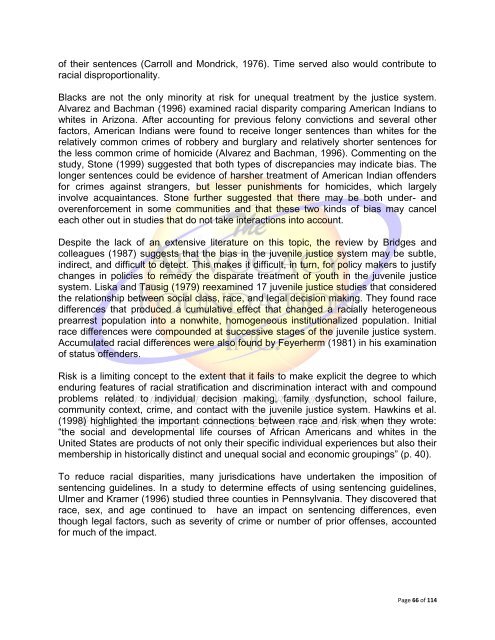African-American Youth in The Juvenile Justice System
African-American Youth in The Juvenile Justice System
African-American Youth in The Juvenile Justice System
Create successful ePaper yourself
Turn your PDF publications into a flip-book with our unique Google optimized e-Paper software.
of their sentences (Carroll and Mondrick, 1976). Time served also would contribute to<br />
racial disproportionality.<br />
Blacks are not the only m<strong>in</strong>ority at risk for unequal treatment by the justice system.<br />
Alvarez and Bachman (1996) exam<strong>in</strong>ed racial disparity compar<strong>in</strong>g <strong>American</strong> Indians to<br />
whites <strong>in</strong> Arizona. After account<strong>in</strong>g for previous felony convictions and several other<br />
factors, <strong>American</strong> Indians were found to receive longer sentences than whites for the<br />
relatively common crimes of robbery and burglary and relatively shorter sentences for<br />
the less common crime of homicide (Alvarez and Bachman, 1996). Comment<strong>in</strong>g on the<br />
study, Stone (1999) suggested that both types of discrepancies may <strong>in</strong>dicate bias. <strong>The</strong><br />
longer sentences could be evidence of harsher treatment of <strong>American</strong> Indian offenders<br />
for crimes aga<strong>in</strong>st strangers, but lesser punishments for homicides, which largely<br />
<strong>in</strong>volve acqua<strong>in</strong>tances. Stone further suggested that there may be both under- and<br />
overenforcement <strong>in</strong> some communities and that these two k<strong>in</strong>ds of bias may cancel<br />
each other out <strong>in</strong> studies that do not take <strong>in</strong>teractions <strong>in</strong>to account.<br />
Despite the lack of an extensive literature on this topic, the review by Bridges and<br />
colleagues (1987) suggests that the bias <strong>in</strong> the juvenile justice system may be subtle,<br />
<strong>in</strong>direct, and difficult to detect. This makes it difficult, <strong>in</strong> turn, for policy makers to justify<br />
changes <strong>in</strong> policies to remedy the disparate treatment of youth <strong>in</strong> the juvenile justice<br />
system. Liska and Tausig (1979) reexam<strong>in</strong>ed 17 juvenile justice studies that considered<br />
the relationship between social class, race, and legal decision mak<strong>in</strong>g. <strong>The</strong>y found race<br />
differences that produced a cumulative effect that changed a racially heterogeneous<br />
prearrest population <strong>in</strong>to a nonwhite, homogeneous <strong>in</strong>stitutionalized population. Initial<br />
race differences were compounded at successive stages of the juvenile justice system.<br />
Accumulated racial differences were also found by Feyerherm (1981) <strong>in</strong> his exam<strong>in</strong>ation<br />
of status offenders.<br />
Risk is a limit<strong>in</strong>g concept to the extent that it fails to make explicit the degree to which<br />
endur<strong>in</strong>g features of racial stratification and discrim<strong>in</strong>ation <strong>in</strong>teract with and compound<br />
problems related to <strong>in</strong>dividual decision mak<strong>in</strong>g, family dysfunction, school failure,<br />
community context, crime, and contact with the juvenile justice system. Hawk<strong>in</strong>s et al.<br />
(1998) highlighted the important connections between race and risk when they wrote:<br />
“the social and developmental life courses of <strong>African</strong> <strong>American</strong>s and whites <strong>in</strong> the<br />
United States are products of not only their specific <strong>in</strong>dividual experiences but also their<br />
membership <strong>in</strong> historically dist<strong>in</strong>ct and unequal social and economic group<strong>in</strong>gs” (p. 40).<br />
To reduce racial disparities, many jurisdications have undertaken the imposition of<br />
sentenc<strong>in</strong>g guidel<strong>in</strong>es. In a study to determ<strong>in</strong>e effects of us<strong>in</strong>g sentenc<strong>in</strong>g guidel<strong>in</strong>es,<br />
Ulmer and Kramer (1996) studied three counties <strong>in</strong> Pennsylvania. <strong>The</strong>y discovered that<br />
race, sex, and age cont<strong>in</strong>ued to have an impact on sentenc<strong>in</strong>g differences, even<br />
though legal factors, such as severity of crime or number of prior offenses, accounted<br />
for much of the impact.<br />
Page 66 of 114

















